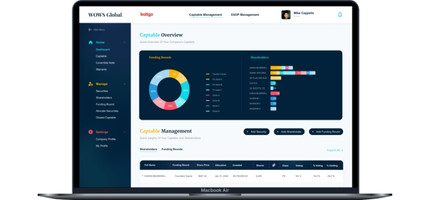Mastering Waterfall Analysis in Cap Tables: A Comprehensive Guide
Waterfall Analysis Cap Table

In today's dynamic business landscape, understanding and maximizing returns in various exit scenarios is crucial for investors and business owners alike. One powerful tool that facilitates this comprehension is the "waterfall analysis" in a cap table. In this comprehensive guide, we'll delve deeper into the intricacies of waterfall analysis, exploring its significance, functionality, and key features.
What is Waterfall Analysis?
Definition:
Waterfall analysis is a sophisticated financial modeling method that delineates how exit revenues are distributed among a company's stakeholders. It provides a sequential breakdown of the distribution process, revealing intermediate values and potential 'leakage' points.
Visualizing with Waterfall Charts:
A waterfall chart, a unique type of bar chart, is commonly used to illustrate the overall value shift between two points in the distribution process. Unlike traditional bar graphs, waterfall charts break down the total change into constituent parts, offering a visual representation of gains and losses.
How Does Waterfall Analysis Work?
Process:
The complexity of economic return modeling is simplified through waterfall analysis. By starting with an initial value and sequentially breaking down the process, businesses can monitor data at every stage, helping investors make informed decisions about cash flow allocation.
Versatility of Waterfall Charts:
Waterfall charts are versatile, capable of displaying data in sequential or category formats. Whether visualizing positive or negative growth, these charts effectively showcase the evolution of values over time, providing a comprehensive overview of changes.
Why Businesses Need Waterfall Analysis?
Unraveling Causes and Effects:
Waterfall analysis aids businesses in understanding the chain of causes and effects that lead to positive or negative outcomes. Rather than just examining total earnings, it helps identify the specific sources of profit, providing valuable insights for management and owners.
Predictability for Management:
Senior management often prefers the structured and predictable nature of waterfall-style project management. It simplifies communication of the project's current status by presenting quantitative value changes over time as a series of small percentage shifts.
Equity Distribution with Waterfall Analysis and Cap Table
Cap Table Overview:
A capitalization table (cap table) breaks down the ownership stakes of a corporation, detailing various forms of equity such as common equity shares, preferred equity shares, warrants, and convertible equity. It plays a critical role in determining ownership percentages, influencing board composition and subsequent investment rounds.
Updating Cap Tables:
With each fundraising round or significant change in ownership, a company must update its cap table to reflect adjustments in share issuance, stock option grants, and new security shares. Waterfall analysis reveals potential equity distribution in the event of a liquidity event, helping shareholders anticipate outcomes.
Key Features in Waterfall Analysis and Cap Table
1. Structure of Capital:
Consideration of a startup's debt, convertible notes, preferred stock, and warrants is crucial. The exit waterfall model must account for the relative seniority of different equity instruments and the company's debt-to-equity ratio.
2. Ownership Rights:
Early-stage investors' returns are sensitive to factors such as liquidation preference, dividends, anti-dilution protection, conversion rights, and vesting requirements for options. Warrants, options, and other rights impact equity distribution and should be carefully analyzed.
3. Exit Strategy:
The analysis for a merger and acquisition exit differs significantly from an initial public offering. Understanding the impact of unique structures, lock-ups, and complexities of each exit scenario is essential for an accurate waterfall model.
4. Equity and Share Types:
A company's total capital is divided into discrete parts, with each share representing a proportion of ownership. Understanding different share types, such as cumulative stockholders' rights to receive dividend arrears, is vital for accurate equity distribution.
How to Use Exit Waterfall in the Cap Table?
Leveraging Cap Tables:
The exit waterfall utilizes the cap table to examine profit distribution based on various liquidation preference structures, conversion situations, and share class seniority. Companies can analyze profits across different exit values, adjusting the distribution based on preferred equity share class designations.
Designating Preferred Equity:
Preferred equity share classes can be categorized as nonparticipating, fully participating, or participating with a cap. The model automatically adjusts profit distribution based on these designations, providing valuable insights into the impact of different exit scenarios.
Conclusion:
Mastering waterfall analysis in a cap table is essential for businesses seeking to optimize returns and understand the intricacies of equity distribution. By comprehending the process, visualizing data with waterfall charts, and considering key features, businesses can make informed decisions in various exit situations, ultimately maximizing profitability for stakeholders.
Related Posts
-

Investment AI Innovation Smart Cities Smart Fintech Analysis
MTR Lab: Investing in the Future of Smart Cities
MTR Lab is the strategic venture arm of MTR Corporation, investing in early-growth startups driving smart city and sustainability innovation. With a focus on urban tech, from clean energy and mobility to PropTech and smart logistics. MTR Lab helps founders scale impactful solutions across Hong Kong and beyond. -

cap table investor relations
Is Your Investor "Cap Table Material"?
Choosing the right investor is like finding a life partner—make sure they’re “cap table material.” Our cheeky checklist will help you spot the keepers from the flings. Read on! -

Cap Table Blunders
Avoid these Cap Table Blunders for Your Startup Success
In the dynamic world of startups, securing venture capital funding can be a pivotal moment that propels a company to new heights. However, the path to securing this coveted funding is fraught with challenges, and one critical aspect that can either attract or deter investors is the cap table. A well-managed cap table not only reflects the financial health of a startup but also signals its governance and leadership structure. In this article, we will delve into the potential cap table blunders that could hinder a startup's chances of securing venture capital funding and discuss strategies to steer clear of these pitfalls. -

Cap Table
How to Manage Your Cap Table: A Step-by-Step Guide
Are you a startup founder or entrepreneur struggling with cap table management? Look no further. In this comprehensive article, we have created a step-by-step checklist to simplify the daunting task of managing your cap table. From initial setup to ongoing maintenance, we've got you covered. -

Cap Table
What Is a Cap Table? The Complete Guide to Equity Management
So you’ve started a company and are ready to bring on investors or hire employees. But before you do, you need to get your equity management in order. What does that even mean? Simply put, you need to create a capitalization table, or cap table for short. A cap table tracks who owns shares of your company and details like the type of shares, percentage owned, and value. It’s one of the most important documents for any business. -

Cap Table Startup
4 Reasons Every Startup Should Use a Digital Cap Table
A capitalization table (cap table) is a record of a company’s ownership structure accompanied by the information of the relevant stakeholders. In recent times, companies will often have multiple types of securities from common stock and preferred shares to convertible notes, warrants and options, each with its own unique vesting periods and owned by a multitude of different shareholders. Managing these ever-changing equity structures and various securities as companies go through fundraising rounds can be tedious and time-consuming on manual spreadsheets.
